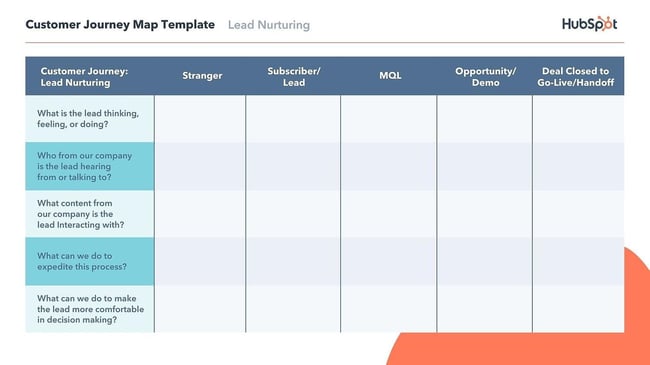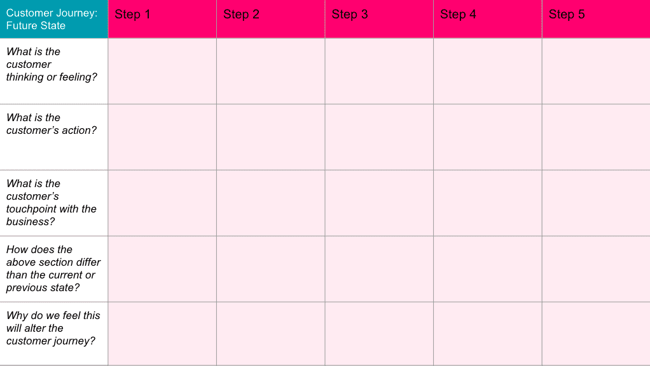Getting into the minds of your customers can be challenging. Once you think you’ve got their every want and need accounted for, new technology, preferences, and buying trends emerge.

You may wonder why a customer spends so long browsing your selection and adding products to their cart just to close the tab, or why it's taking your customers several steps to get from point A to point B when it should only take one.
Whatever the confusion may be, the root cause is that you most likely don't have a clear grasp of the customer’s journey to purchasing your product or service.
The customer journey is the process by which a customer interacts with a company in order to achieve a goal. Today's consumers interact with brands in ways that are tricky to pin down. From gaining awareness of a brand via social media, to receiving a "thank you for your purchase" email after a successful transaction, there are usually many and varied steps in between.
This isn't something you can assume or predict based on your internal perspective. A customer journey is very specific to the physical experiences your customers have. Thus, the best way to understand the journeys of your customers is by asking them.
In this post, we'll explain everything you need to know about the customer journey, including what it is and how to map it. But, if you're in a rush, you can use the links below to navigate to the exact information you're looking for.
.webp)
Free Customer Journey Template
Outline your company's customer journey and experience with these 7 free templates.
- Buyer's Journey Template
- Future State Template
- Day-in-the-Life Template
- And more!
Download Free
All fields are required.
.webp)
Free Marketing Planning Template
A free template to help you plan your marketing strategy
Table of Contents
- Customer Journey
- Customer Journey Mapping
- How to Create a Customer Journey Map
- Types of Customer Journey Maps
- Customer Journey Map Best Practices
- Benefits of Customer Journey Mapping
- Customer Journey Map Examples
- Free Customer Journey Map Templates
Customer Journey Map
A customer journey map is a visual representation of the process a customer or prospect goes through to achieve a goal with your company. The goal may be making a purchase, signing up for a newsletter, joining a loyalty program, or anything in between. With the help of a customer journey map, you’ll get a better understanding of what will motivate your customers to achieve these goals.
However, simply understanding the customer journey isn't enough. It's best to visualize this complicated journey into a diagram that you and other employees can refer to as a resource. This is where designing a customer journey map comes into play.
Customer Journey Mapping
Customer journey mapping is the process of visualizing how a customer interacts with a business by mapping out the actions they take to achieve a goal. Customer journey mapping outlines key events, customer motivations, and areas of friction within their experience. Then, this information is combined into a comprehensive visual that describes a customer’s typical experience with your business.
By understanding this relationship, you can structure your touchpoints to create the most effective and efficient process for your customers. A customer journey map visualizes the current process customers take, from the first to final touchpoint, to see if they’re currently reaching their goals and, if not, how they can.
The customer journey can rarely be represented in a linear journey from point A to point B because buyers often take a back and forth, cyclical, multi-channel journey. This makes customer journey mapping difficult to accurately visualize.
For this reason, savvy business leaders use a variety of methods to represent the journey, from post-it notes on a boardroom wall, to Excel Spreadsheets, to infographics. The most important thing is that the map makes sense to those who'll be using it.
However, before you can dive into creating your customer journey map, you need to first collect data from your customers and prospects. The process of creating an effective customer journey map is extensive but valuable.
Featured Resource: Customer Journey Map Template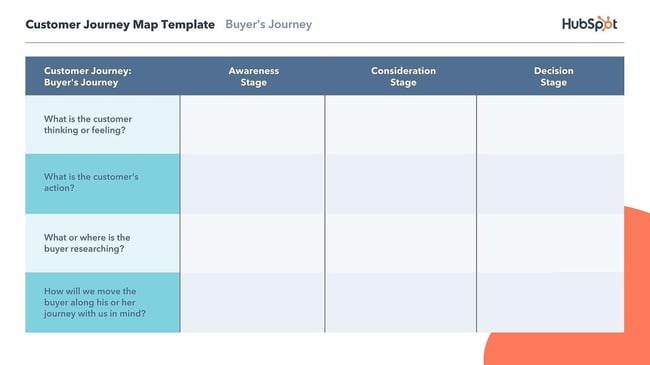
What's included in a customer journey map?
- The Buying Process
- User Actions
- Emotions
- Pain Points
- Solutions
A customer journey map includes significant milestones in the customer journey. You’ll begin by drafting the path your business intends for a customer to take in order to reach a goal. Using the typical buying process stages, you’ll list each stage horizontally.

Free Marketing Plan Template
Outline your company's marketing strategy in one simple, coherent plan.
- Pre-Sectioned Template
- Completely Customizable
- Example Prompts
- Professionally Designed
Download Free
All fields are required.

This element of the customer journey map details what a customer does in each stage of the buying process. They might speak with friends and family about their needs and potential ways to fulfill those needs in the awareness stage. From there, they might take a demo on your website, and then finally, they’ll use cash or a debit card to make their purchase. This element explores the various ways your customers might achieve the goal.
Whether the goal is big or small, it’s important to remember your customers are solving a problem. That means they’re probably feeling some emotion — whether that is relief, happiness, excitement, or worry. If your process is long or complicated, they might feel a range of emotions at every stage. Adding these emotions to the journey map can help you mitigate negative emotions about the journey so that they don’t become negative opinions about your brand.
Where there is a negative emotion, there’s a pain point that caused it. Adding pain points to your customer journey map can help you identify which stage your customer is experiencing negative emotions and deduce the reason why.
As the final element in your customer journey map, solutions are where you and your team will brainstorm potential ways to improve your buying process so that customers encounter fewer pain points and have positive moods as they patronize your business.
What is a touchpoint in a customer journey map?
A touchpoint in a customer journey map is an instance where your customer can form an opinion of your business. Touchpoints can be found in places where your business comes in direct contact with the potential or existing customer. A display ad, an interaction with an employee, a 404 error, and even a Google review can be considered a customer touchpoint.
Your brand exists beyond your website and marketing materials, so it’s important that the different types of touchpoints are considered in your customer journey map because they can help uncover opportunities for improvement in the buying journey.
How to Create a Customer Journey Map
- Set clear objectives for the map.
- Profile your personas and define their goals.
- Highlight your target customer personas.
- List out all the touchpoints.
- Identify the elements you want your map to show.
- Determine the resources you have and the ones you'll need.
- Take the customer journey yourself.
- Make necessary changes.
1. Set clear objectives for the map.
Before you can dive into creating your map, you need to ask yourself why you are making one in the first place. What goals are you directing this map towards? Who is it specifically about? What experience is it based upon?
Based on this, you may want to create a buyer persona. This is a fictitious customer with all of their demographics and psychographics who represents your average customer. Having a clear persona is helpful in reminding you to direct every aspect of your customer journey map towards them.
2. Profile your personas and define their goals.
Next, you should conduct research. Some great ways to get valuable customer feedback is through questionnaires and user testing. The important thing is to only reach out to actual customers or prospects.
You want the feedback of people who are actually interested in purchasing your products and services and who have interacted with your company before or plan to do so.
Some examples of good questions to ask are:
- How did you hear about our company?
- What first attracted you to our website?
- What are the goals you want to achieve with our company? In other words, what problems are you trying to solve?
- How long have you / do you typically spend on our website?
- Have you ever made a purchase with us? If so, what was your deciding factor?
- Have you ever interacted with our website with the intent of making a purchase but decided not to? If so, what led you to this decision?
- On a scale of 1 to 10, how easy is it for you to navigate our website?
- Did you ever require customer support? If so, how helpful was it, on a scale of 1 to 10?
- Is there any way that we can further support you to make your process easier?
You can use this buyer persona tool to fill in the details you procure from customer feedback.
3. Highlight your target customer personas.
Once you've learned about the different customer personas that interact with your business, you'll need to narrow your focus on one or two of them. Remember, a customer journey map tracks the experience of one customer who's taking a very specific path with your company. If you group too many personas into one journey, your map won't accurately reflect your customers' experience.
If you're creating your first map, it's best to pick your most common customer persona and consider the route they would typically take when engaging with your business for the first time. You can use a marketing dashboard to compare each one and determine which would be the best fit for your journey map. Don't worry about the ones you leave out, as you can always go back and create a new map that's specific to these customer types.
4. List out all the touchpoints.
Touchpoints are all the places on your website that your customers can interact with you. Based on your research, you should list out all the touchpoints your customers and prospects are currently using, as well as the ones you believe they should be using if there is no overlap.
This is an important step in creating a customer journey map because it gives you insight into what actions your customers are performing. If they are using fewer touchpoints than expected, does this mean they are quickly getting turned away and leaving your site early? If they are using more than expected, does this mean your website is complicated and it requires them several steps to get to an end goal?
Whatever the case may be, understanding the touchpoints is a tool that can help you understand the ease and objectives of customer journeys.
This doesn't just mean your website. You need to look at all the ways in which your customer might come across you online. These might include:
- Social channels
- Paid ads
- Email marketing
- Third-party review sites or mentions
Run a quick Google search of your brand to see all the pages that mention you. Verify these by checking in on your Google Analytics to see where your traffic is coming from.
Whittle your list down to those touchpoints that are the most common and will be most likely to see an action associated with it.
Actions
List out all of the actions your customers perform throughout their interaction with your brand. This might be a Google search for your keywords or clicking on an email from you. You may wind up with a long list of actions. That's fine. You'll get a chance to rationalize your information later.
It's important to recognize when customers are being expected to take too many actions to achieve their goals. Reducing the number of steps a customer needs to take can feel risky, but pays off in higher conversion rates.
Emotions & Motivations
All marketing is a result of cause and effect. Likewise, every action your customer takes is motivated by emotion. And your customer's emotions will change depending on which part of their journey they're at.
The emotional driver of each of your customer's actions is usually caused by a pain point or a problem. Knowing this will help you to provide the right content at the right time so that you smooth the customer's emotional journey through your brand.
Obstacles & Pain Points
Get to know what roadblocks are stopping your customer from making their desired action. One common obstacle is cost. For example, one of your customers could love your product but abandon their cart upon discovering unexpectedly high shipping rates.
Highlighting these potential obstacles in your customer journey can help you mitigate them. For example, you could provide an FAQ page that answers common questions about shipping costs.
5. Determine the resources you have and the ones you'll need.
Your customer journey map is going to touch on nearly every part of your business. This will highlight all of the resources that go into creating the customer experience. So, it's important to take inventory of the resources you have and the ones you'll need to improve the customer's journey.
For example, maybe your map highlights some flaws in your customer service offer and you notice that your team doesn't have the tools they need to properly follow up with customers after a service interaction. Using your map, you can advise management to invest in customer service tools that will help your team manage customer demand.
And, by including these new tools in your map, you can accurately predict how they'll impact your business and drive outsized value. This makes it much easier to convince gatekeepers and decision-makers to invest in your proposals.
6. Take the customer journey yourself.
Just because you've designed your map doesn't mean your work is done. This is the most important part of the process: analyzing the results. How many people are clicking to your website but then closing out before making a purchase? How can you better support customers? These are some of the questions you should be able to answer with your finished map.
Analyzing the results can show you where customer needs aren’t being met. By approaching this, you can ensure that you are providing a valuable experience and making it clear that people can find solutions to their problems with your company's help.

Free Marketing Plan Template
Outline your company's marketing strategy in one simple, coherent plan.
- Pre-Sectioned Template
- Completely Customizable
- Example Prompts
- Professionally Designed
Download Free
All fields are required.

The whole exercise of mapping the customer journey remains hypothetical until you try it out yourself.
For each of your personas, follow the journey they take through their social media activity, through to reading their emails, through to searching online.
7. Make the necessary changes.
Your data analysis should give you a sense of what you want your website to be. You can then make the appropriate changes to your website to achieve these goals. Perhaps this is making more distinct call-to-action links. Or, maybe, it's writing longer descriptions under each product to make its purpose more clear.
No matter how big or small the changes are, they will be effective as they are directly correlated with what customers listed as their pain points. Rather than blindly making changes in the hopes that they will improve customer experiences, you can feel certain that they will. And, with the help of your visualized customer journey map, you can ensure those needs and pain points are always addressed.
Your map should be a constant work-in-progress. Reviewing it on a monthly or quarterly basis will help you to identify gaps and opportunities for streamlining your customer journey further. Use your data analytics along with customer feedback to check for any roadblocks.
I find it useful to keep all stakeholders involved in this process, which is why my maps are usually visualized on Google Sheets shared amongst the people I work closely with. It's also beneficial to have regular meetings (quarterly or yearly) to analyze how new products or offerings might have changed the customer journey.
Types of Customer Journey Maps and Examples
There are four types of customer journey maps, each having their own unique benefits. Depending on the specific purpose you have for the map, you can choose the proper one.
Current State
These customer journey maps are the most widely-used type. They visualize the actions, thoughts, and emotions your customers currently experience while interacting with your company. They are best used for continually improving the customer journey.

Day in the Life
These customer journey maps visualize the actions, thoughts, and emotions your customers currently experience in all the activities in which they partake on a daily basis, whether or not that includes your company. This type gives a wider lens into the lives of your customers and what their pain points are in real life. They are best used for addressing unmet customer needs before customers even know they exist. Your company may use this type of customer journey map when exploring new market development strategies.
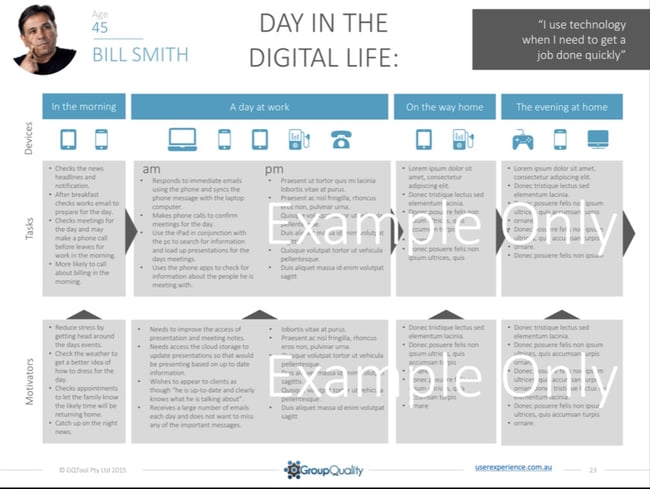
Future State
These customer journey maps visualize what actions, thoughts, and emotions your customers will experience in future interactions with your company. Based on what their current experience is, you’ll have a clear picture of where your business fits in. They are best used for illustrating your vision and setting clear, strategic goals.

Service Blueprint
These customer journey maps begin with a simplified version of one of the above map styles. Then, they layer on the factors responsible for delivering that experience, including people, policies, technologies, and processes. They are best used for identifying the root causes of current customer journeys or identifying the steps needed to attain desired future customer journeys.
Customer Journey Mapping Best Practices
- Set a goal for the journey map.
- Survey customers to understand their buying journey.
- Ask customer service reps about the questions they receive most frequently.
- Create a customer journey map for each buyer persona.
- Review and update each journey map after every major product release.
- Make the customer journey map accessible to cross-functional teams.
1. Set a goal for the journey map.
Determine whether you’re aiming to improve the buying experience or launch a new product. Knowing what you need the customer journey map to tell you can prevent scope creep on a large project like this.
2. Survey customers to understand their buying journey.
What you know about the customer experience and what they actually experience can be two very different things. Ask your customers directly what it’s like doing business with your company so you have a more accurate snapshot of the customer’s journey.
3. Ask customer service reps about the questions they receive most frequently.
Sometimes, customers aren’t aware of their specific pain points — they simply feel when something isn’t working for them. That’s where your customer service reps come in. They can help fill in the gaps and translate customer pain points into business terms that you and your team can understand and act on.
4. Create a customer journey map for each buyer persona.
It’s easy to assume each customer operates the same way, but that couldn't be further from the truth. Demographics, psychographics, and even how long someone has been a customer can determine the way a person interacts with your business and makes purchasing decisions. Group overarching themes into buyer personas and create a customer journey map for each one.
5. Review and update each journey map after every major product release.
Every time your product or service changes, the customer’s buying process changes too. Even a slight tweak, like adding an additional field to a lead form, can become a significant roadblock for customers. So, it’s important to review the customer journey map before and after implementing changes.
6. Make the customer journey map accessible to cross-functional teams.
Customer journey maps aren’t very valuable in a silo. Creating a journey map is a convenient way to bring cross-functional teams together to provide feedback. Afterward, make a copy of the map accessible to each team so they always keep the customer top of mind.
.webp)
Free Customer Journey Template
Outline your company's customer journey and experience with these 7 free templates.
- Buyer's Journey Template
- Future State Template
- Day-in-the-Life Template
- And more!
Download Free
All fields are required.
.webp)
Benefits of Customer Journey Mapping
You might be telling yourself, "This doesn't seem necessary for me or my company. We understand the needs and pain points of our customers, thank you very much." This may be true at surface level.
However, breaking down the customer journey phase by phase, aligning each step with a goal, and restructuring your touchpoints accordingly are essential steps towards maximizing customer success. After all, everything you do should be about solving customer problems and helping them achieve long-term success with your product or service.
1. You can refocus your company with an inbound perspective.
Rather than trying to discover your customers through outbound marketing, you can have your customers discover you with the help of inbound marketing. Outbound marketing involves tactics that are poorly targeted at generalized or uninterested audiences and that seek to interrupt customers from their daily lives.
Outbound marketing is costly and inefficient. It annoys and deters customers and prospects. Inbound marketing involves creating interesting content that is useful and that your customers are already searching for. It grabs their attention first and focuses on the sales later.
By mapping out the customer journey, you can understand what is interesting and helpful to your customers about your company and website, and what is turning them away. You can create the kind of content that will attract them to your company and keep them there.
2. You can create a new target customer base.
If you don't properly understand the customer journey, you probably don't completely know the demographics and psychographics of your customers. This is dangerous; it's a waste of time and money to repeatedly target too broad of an audience than who will actually be interested in your products, services, and content.
Researching the needs and pain points of your typical customers and mapping out their journey will give you a good picture of the kinds of people who are trying to achieve a goal with your company. Thus, you can hone in your marketing to that specific audience.
3. You can implement proactive customer service.
A customer journey map is like a roadmap to the customer's experience. It shows you moments where people will experience delight as well as situations where they might be faced with friction. Knowing this ahead of time allows you to plan your customer service strategy accordingly, and intervene at ideal times that maximize your brand's value to the buyer.
Proactive customer service also makes your brand appear more reliable to your customer base. For example, if it's around the holidays and you're anticipating a customer service surge, you can send a message to your customers letting them know about your team's adjusted holiday hours.
You can also let them know about additional support options if your team is unavailable and what to do if there's an urgent problem that needs immediate attention.
This way, customers won't feel surprised if they're waiting on hold a little longer than usual or call you outside your new working hours. They'll even have alternative options to choose from — like a chatbot or knowledge base — if they need to find a faster solution.
4. You can improve your customer retention rate.
When you have a complete view of the customer journey, it's easier to pick out areas where you can stand to improve it. When you do, customers experience fewer pain points which leads to fewer people leaving your brand for competitors. After all, 33% of customers will consider switching brands after just one poor experience.
Customer journey mapping can point out individuals who are on the path to churn. If you log the common behaviors and actions that these customers have, you can start to spot them before they leave your business. While you might not save them all, it's worth the try since attaining a new customer is 5-25 times more expensive than retaining an existing one.
5. You can create a customer-focused mentality throughout the company.
As your company gets larger, it can be hard to coordinate all the departments to be as customer-focused as your customer service, support, and success teams. They can often have sales and marketing goals that aren't based on what real customers want.
A clear customer journey map can be shared with your entire organization. The great thing about these maps is that they map out every single step of the customer journey from initial attraction to post-purchase support. And, yes, this concerns marketing, sales, and service.
Based on this rationale, you can't deny the importance of a customer journey map. Thus, we've created the following steps for crafting the best map to help your company and customers prosper.
Customer Journey Mapping Examples
1. HubSpot's Customer Journey Map Templates
Download a free, editable customer journey map template.
Download a free, editable customer journey map template.
HubSpot's free Customer Journey Map Templates provide an outline for companies to understand their customers' experiences. Download them today to start working on your customer journey map.
2. B2B Customer Journey Map Example![]()

This customer journey map clearly outlines the five steps Dapper Apps believes a customer goes through when interacting with them. As you can see, it goes beyond the actual purchasing phase by incorporating initial research and post-purchase needs.
This map is effective because it helps employees get into the mind of the customer by understanding the normal questions they have and the emotions they're feeling. There are incremental action steps that Dapper Apps can take in response to these questions and feelings that will help it solve all the current problems customers are having.
3. Ecommerce Customer Journey Map Example

This fictitious customer journey map is a clear example of a day in the life map. Rather than just focusing on the actions and emotions involved with the customer's interaction with the company, this map outlines all the actions and emotions the customer experiences on a normal day.
This map is helpful because it measures a customer's state of mind or emotional state based on the level of freedom they get from certain stimuli. This is helpful for a company that wants to understand what its target customers are stressed about and what problems may need solving that they don't even know exist.
4. Future B2C Customer Journey Map Example
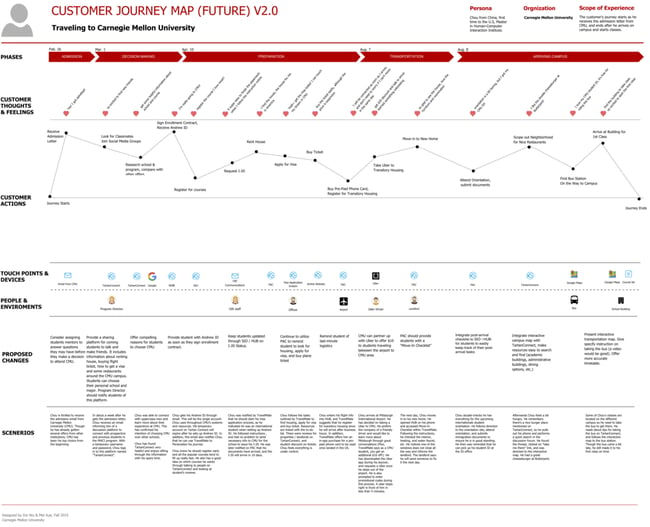
This customer journey map, designed for Carnegie Mellon University, exemplifies the usefulness of a future state customer journey map. It outlines the thoughts, feelings, and actions the university wants its students to be having and the touchpoints, devices, people, and environments it wants students to be interacting with.
Based on these goals, CMU chose specific proposed changes for each phase and even wrote out example scenarios for each phase. This is a clear diagram that can visualize the company vision and help any department understand where they will fit into building a better user experience.
5. Retail Customer Journey Map Example

This customer journey map shows an in-depth customer journey map of a customer interacting with a fictitious restaurant. It's clear that this style of map is more comprehensive than the others as it includes the front of stage (direct) and back of stage (non-direct or invisible) interactions a customer has with the company, as well as the support processes.
This map is more complicated, but it lays out every action involved in the customer experience, including those of the customer, employees directly serving, and employees working behind the scenes. By analyzing how each of these factors influences the customer journey, a company can find the root cause of mishaps and problem-solve this for the future.
Free Customer Journey Map Templates
1. Current State Template
If you're using this template for a B2B product, the phases may reflect the search, awareness, consideration of options, purchasing decision, and post-purchase support processes. For instance, in the Dapper Apps example, its phases were research, comparison, workshop, quote, and sign-off.
2. Day in the Life Template
Since this template reflects all the thoughts, feelings, actions, needs, and pain points a customer has in their entire daily routine — whether or not that includes your company — you'll want to map out this template in a chronological structure. This way, you can highlight the times of day at which you can offer the best support.
Click here for an interactive day in the life template.
3. Future State Template
Similar to the current state template, these phases may also reflect the future predicted or desired search, awareness, consideration of options, purchasing decision, and post-purchase support processes. Since this takes place in the future, you can tailor these phases based on what you'd like the customer journey to look like, rather than what it currently looks like.
.webp)
Free Customer Journey Template
Outline your company's customer journey and experience with these 7 free templates.
- Buyer's Journey Template
- Future State Template
- Day-in-the-Life Template
- And more!
Download Free
All fields are required.
.webp)
Click here for an interactive future state template.
4. Service Blueprint Template
Since this template is more in-depth, it doesn't follow certain phases in the customer journey. Rather, it is based on physical evidence — the tangible factors that can create impressions about the quality and prices of the service — that often come in sets of multiple people, places, or objects at a time.
For instance, in the fictitious restaurant example above, the physical evidence includes all of the staff, tables, decorations, cutlery, menus, food, and anything else a customer comes into contact with.
You would then list out the appropriate customer actions and employee interactions to correspond with each physical evidence.
For example, when the physical evidence is plates, cutlery, napkins, and pans, the customer gives their order, the front-of-stage employee — the waiter — takes the order, the back-of-stage employee — the receptionist — processes the order, and the support processes — the chefs — prepare the food.
Click here for an interactive service blueprint template.
5. Buyer's Journey Template
You can also use the classic buyer's journey — awareness, consideration, and decision — to design your customer journey map.
Click here for an interactive buyer's journey template.
Charter the Path to Customer Success
Once you fully understand your customer’s experience with your business, you can delight them at every stage in their buying journey. There are many factors that can affect this journey including customer pain points, emotions, and your company’s touchpoints and processes.
A customer journey map is the most effective way to visualize this information, whether you’re optimizing your journey for the customer or exploring a new business opportunity to serve a customer’s unrecognized needs. Use the free templates in this article to start mapping the future of customer success in your business.
Editor's note: This post was originally published in August, 2018 and has been updated for comprehensiveness.


